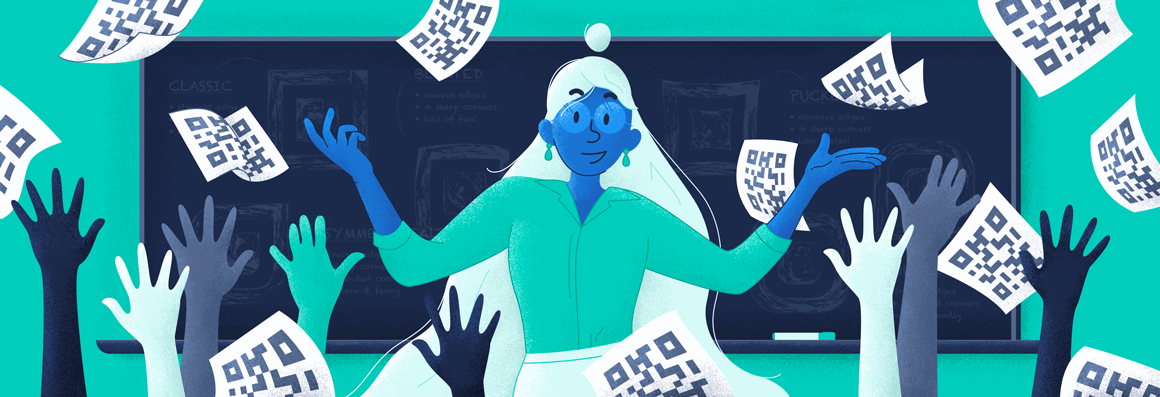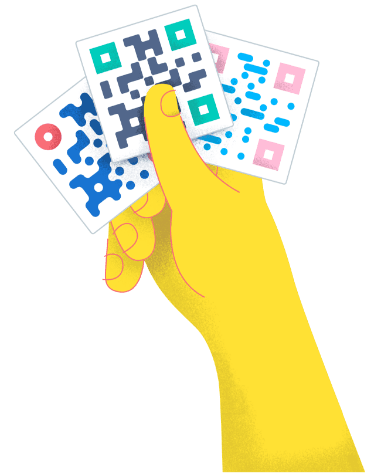- Best Practices ●
- COVID-19 ●
- Industry Trends ●
- Partners ●
- Product ●
6 Ways to Foster Student Learning With QR Codes in Books
Looking to elevate your readers’ experiences and add an interactive edge to your books? Quick Response (QR) Codes offer the perfect solution.
With their unique ability to merge the physical and digital worlds, QR Codes add a dynamic layer that text alone can’t achieve—making learning more engaging and accessible. Educators already use QR Codes in the classroom to connect students with everything from immersive videos to accessible learning content, creating a more inclusive and engaging environment. Now you can do the same to make each page of your book unforgettable.
With options to embed digital resources that readers can instantly access on their mobile devices, QR Codes transform books into versatile learning tools. In this post, we look at some of the best ways to leverage these codes in books to amplify student learning.
*Note: All brands and examples discussed below were found during our online research for this article.
-
Table of contents
- 1. Overcome accessibility hurdles by sharing audiobooks
- 2. Overcome barriers to reading by providing alternative texts
- 3. Support learners by providing supplemental materials
- 4. Engage young learners with visual aids
- 5. Connect authors and readers on social media
- 6. Provide recommendations for supplemental reading
Whether you’re an author, educator, or publisher, QR Codes offer countless ways to enrich student learning through your books. Here are some effective ways to use them to create an engaging, interactive experience.
1. Overcome accessibility hurdles by sharing audiobooks
According to the Cooper Institute, 60% of students struggling with learning may have undetected or untreated vision problems. Moreover, learning disabilities like dyslexia affect as many as one in five people. This often means that many students are unable to take advantage of written learning materials as effectively as their peers, resulting in poor performance.
With these numbers in mind, providing alternative formats like audiobooks is essential for accessibility. QR Codes for audiobooks make it easy for both publishing houses and self-publishing authors to offer both written and audio content—just add a code to the book cover, pages, or even bookmarks to connect readers to audio versions.
Beyond overcoming the barriers of written text, audiobooks offer students flexibility, allowing them to listen and learn on the go—whether they’re commuting, handling household chores, or even working out.
If you’re ready to support accessible learning options, start by recording an audio version of your book and creating an MP3 QR Code.
2. Overcome barriers to reading by providing alternative texts
With 21% of students in the U.S. speaking a language other than English at home and 5% facing challenges with English, there’s a growing need for alternative language resources in schools. However, providing books in every language isn’t feasible for most institutions.
By leveraging QR Codes, authors can include codes that direct readers to alternative text translations, promoting inclusivity and equal access to information. This approach is especially valuable for authors serving multicultural classrooms.
QR Codes in higher education also enhance accessibility by offering large print versions of text—a helpful option for older students or those with visual impairments. Providing easy access to alternative text through QR Codes not only enhances convenience but also supports knowledge retention, empowering authors and publishers to reach a broader audience.
Creating these options is easy—just generate PDF QR Codes that link to documents with translated or larger-font text. Add a clear call to action so readers know what to expect, such as, “Scan me for the Spanish version of this book” or “Scan here for a large-print version.”
3. Support learners by providing supplemental materials
Understanding complex concepts can be challenging, which is why educators often supplement core texts with additional resources.
Publishing houses and authors can support this approach by embedding QR Codes that link directly to these materials in books. If you write math textbooks, you could include a code that directs students to official YouTube tutorials on solving complex equations—helping them grasp difficult topics and increasing engagement with your books.
Other supplemental materials to provide with QR Codes include:
- Interactive quizzes: Link QR Codes to online quizzes after every chapter to help learners test their understanding.
- 3D models: For science books like anatomy or chemistry, use Dynamic URL QR Codes to link to interactive 3D models, offering students a visual, in-depth perspective on the material.
- Downloadable PDF worksheets: Use PDF QR Codes to share documents with extra information and exercises to boost students’ understanding.
- Live performances: If you publish music textbooks, include a Video QR Code or a Dynamic URL QR Code to direct students to recorded performances, adding an engaging, real-world layer to music theory.
- Infographics: For visual learners, include Image Gallery QR Codes linked to diagrams or infographics that simplify complex processes.
By adding these materials, you’re creating a more interactive learning experience that can significantly boost students’ understanding and retention.
4. Engage young learners with visual aids
The brain processes images faster than text, making visuals an effective tool for helping students understand and remember key concepts. Visual aids not only make learning more engaging but also keep young learners focused in the classroom.
QR Codes offer an ideal medium for delivering these aids. They’re user-friendly—students (or their parents) can simply point their smartphone camera at a code to access its contents—making them accessible for both young and older audiences. QR Codes for books are also versatile, allowing you to link to infographics, images, and videos. Educators like Nadine Gilkison have successfully used QR Codes in children’s books, linking 66 codes to video books to make publications more interactive and accessible.
The possibilities are endless when it comes to visual content with QR Codes. If you publish picture books or children’s books, consider using Video QR Codes to guide early readers to phonics lessons or read-along videos. For older audiences, like high school or college students, you could use Image Gallery QR Codes to link to infographics that break down complex subjects into more digestible visual forms.
5. Connect authors and readers on social media
We know what you’re thinking—reading and social media don’t seem like a natural pair, but platforms like TikTok have proven otherwise. The trend #BookTok, for example, has inspired many students who don’t typically read to pick up books recommended in the community, whether for leisure or educational purposes. This shows that social media platforms can be a powerful tool for engaging readers.
Using QR Codes to direct students to social media profiles or online learning communities is a simple way to connect readers and authors. Link QR Codes to authors’ social media pages to boost student engagement, offer a glimpse into upcoming book releases, or showcase book trailers. This approach not only enriches the reader’s experience but also supports your marketing strategy by getting new books in front of likely readers.
Choose from various Social Media QR Codes, including X (Twitter) QR Codes, TikTok QR Codes, LinkedIn QR Codes, or Instagram QR Codes. Select the platform where your audience is most active—for instance, an Instagram QR Code if Instagram is popular with your readers. If you’re active on multiple platforms, consider using the Social Media QR Code option to create a landing page with links for each profile.
6. Provide recommendations for supplemental reading
Physical textbooks often face space limitations, making it challenging to include extensive content without driving up printing costs. QR Codes (PDF or Dynamic) offer a convenient solution, allowing you to provide additional reading recommendations without taking up extra page space.
With QR Codes, you can link readers to curated lists of related books, expert interviews, author Q&As, or even author websites for news on upcoming releases. These supplemental resources encourage independent learning and can enhance students’ understanding of the course material, supporting stronger learning outcomes.
Maximize the value of QR Codes in books with a robust QR Code generator
QR Codes are a fantastic way to engage students by enhancing their books’ value. They can connect students to additional resources, including alternative learning materials that are designed with accessibility for all ages and abilities in mind. There’s no limit to how authors, educators, and publishers can foster more successful student learning with the flexibility QR Codes offer!
To bring these ideas to life, start with a reliable QR Code generator—one that lets you link codes to various digital resources and provides customization and tracking capabilities. This way, you can tailor each code to match your brand identity and monitor how readers connect with your content.
QR Code Generator PRO offers an array of QR Code types, allowing you to link directly to supporting content like videos, audio, documents, and more. With options to customize each code’s design, colors, and branding, it’s easy to create codes that seamlessly align with students’ learning materials. With real-time scan data, these codes double as a marketing tool, providing insights into reader preferences and engagement that help you optimize content and track interactions over time.
Sign up for QR Code Generator PRO today to create custom QR Codes that enrich the learning experience.






 Add custom colors, logos and frames.
Add custom colors, logos and frames.

